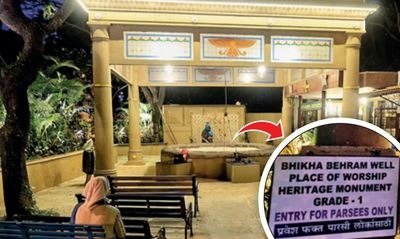Metro-III may endanger fire temples, fear Parsis
 MUMBAI: The upcoming Metro-III project has caused disquiet within the Parsi community as the underground corridor will pass below some of their ancient and most revered fire temples in south Mumbai. Some of these temples were consecrated in the 19th century and the buildings are listed heritage structures.
MUMBAI: The upcoming Metro-III project has caused disquiet within the Parsi community as the underground corridor will pass below some of their ancient and most revered fire temples in south Mumbai. Some of these temples were consecrated in the 19th century and the buildings are listed heritage structures.
Mumbai Metro Rail Corporation (MMRC) officials, executing the Rs 23,000-crore project, said these buildings will neither be touched nor damaged during and after construction. “We will follow protocol to ensure these structures are not affected,” MMRC director (projects) S K Gupta told TOI. But Parsis fear these assurances may not be enough. Structural engineer Jamshed Sukhadwalla said some church buildings in Chennai developed cracks during Metro construction there and he had informed MMRC about this in August 2015.
At Jagannath Sunkersett Marg (Princess Street junction), the Metro tunnels will be built a few metres from two fire temples, which are among the eight Atash Behrams in India. The Wadia Atash Behram at Kalbadevi junction was built in 1830 and the nearby Anjuman Atash Behram came up in 1897. Near Cross Maidan, the Bhikha Behram well built in 1725 is also close to the Metro line. The tunnel will also be passing under the Dadiseth (Agiary) fire temple on D N Road near Flora Fountain. The fire here was consecrated in 1803. Another prominent landmark on D N Road is the J N Petit library, where recently staff members complained the building vibrated when work commenced.
“We have objected, but MMRC assured us that no harm will be done to these structures,” said Burjor Antia, a trustee of Anjuman fire temple and Bhikha Behram well. He said a structural report of the fire temple was recently sent to Metro authorities.
Marzban Giara, chronicler of Parsi history and fire temples in India, said the community is apprehensive that the construction could affect the foundations of these institutions. “Early this year, the well at Dadar Parsi Colony Agiary went dry because of building construction nearby. The foundation of an underconstruction skyscraper is lower than the bottom of the well. How can we rely on the assurances given by the Metro authorities?”
“We understand development must take place. But it is equally important that government engineers guarantee the community that buildings housing our sacred fires will not be destabilized and no damage will occur,” said Firoza Punthakey Mistree, researcher and writer on Zoroastrianism. “The aquifers of Bhika Behram Parsi well need to be protected. The slightest shift or change in the porosity of the soil can affect the water flowing into this sacred well.”
Structural engineer Sukhadwalla, who had raised the red flag about Metro construction in Girgaum, said: “MMRC consultant’s project manager told us to ‘expect the unexpected’ during a meeting with trustees of Bhikha Behram well sometime ago. In this age of advanced technology, the ‘unexpected’ should be minimum. The hardness of the rock can vary. If they come across rock which is much harder, and if the diamond cutters are not effective, they will have to blast it with a small charge. This could cause minor tremors, which can be detrimental to the buildings.”
Gupta said structural reports of the two fire temple buildings at Princess Street junction show they are in “healthy condition”. “We also do not foresee any impact on the wells. The water table here is very high,” he told TOI. He said the Metro tunnel will be at a distance of 1.2m from the boundary wall of Anjuman Atash Behram and 3.5m from that of Wadia Atash Behram. At Dadiseth Agiary, the distance from the centre line of the Metro will be 13m. The depth of the tunnel will be 16m here and 24.7m below road level at Kalbadevi. “The station exit/entry point of Kalbadevi Metro station on JSS Marg will be 7m away from Wadia fire temple,” Gupta added.





